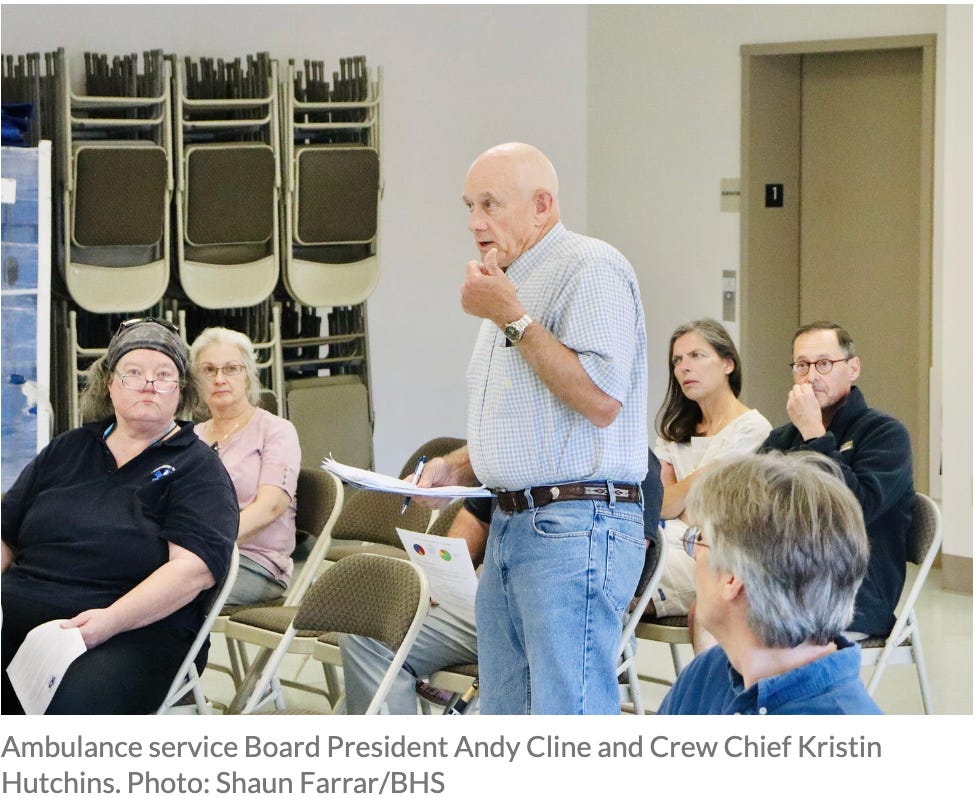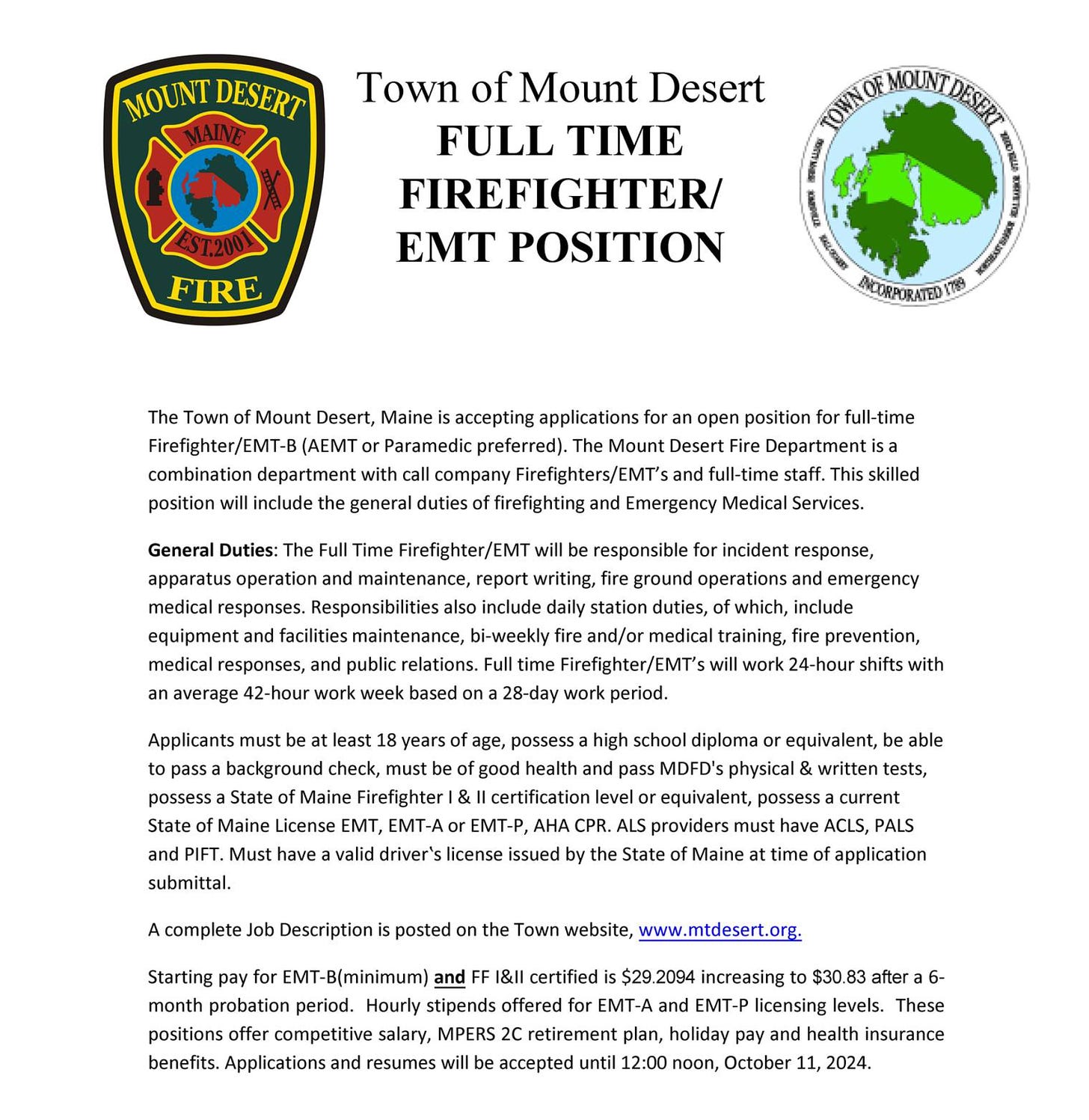Local Ambulance Service Doing All It Can To Survive
The Bar Harbor Story is generously sponsored by Side Street Cafe.
SOUTHWEST HARBOR AND TREMONT—The calls come out over the scanner sporadically sometimes, and other times they come in quick succession.
A seventy-year-old woman is having chest pain and difficulty breathing.
A forty-year-old man with a horrifically broken arm is behind a business in town.
A child has fallen down the stairs and isn’t responding.
There’s been an accident with airbag deployment.
All these calls require medical help. On the west side of Mount Desert Island that help almost always comes from the Southwest Harbor-Tremont Ambulance Service, a nonprofit group that is meant to give people in Tremont and Southwest Harbor quality emergency medical care. That care is needed all day and all night.
Every year, the medical professionals and drivers respond to 400 to 500 calls. Sometimes there will be multiple calls in one day. Sometimes, between calls, there will be gaps of days.
The problem is that this coverage requires the professionals to be available to help, 24 hours a day, seven days a week. That costs money.
This past month, a contingent from the Southwest Harbor-Tremont Ambulance Service gave updates about its structure, needs, and services to the select boards in Tremont and Southwest Harbor.
Kristin Hutchins led the presentation in Southwest Harbor last week saying that the service’s intention is to have a member always on duty and in a room.
It’s a per diem model, which means people serve at will. Lately, they’ve been having a hard time finding ambulance drivers to do that.
“We’ve had a number of retirements and we’re not able to replace them,” she said.
The organization has “four levels of licensure; we got drivers; we got basic EMTs, advanced EMTs, and paramedics,” Southwest Harbor-Tremont Ambulance Service Board President Andrew Cline told the Tremont Select Board in September. “For a number of years, we have been operating with the model of having an EMT or higher licensure on duty at the office in Southwest, where the ambulance is, and a driver on call from home.”
The drivers were initially volunteers and then they started getting paid $2 an hour to be on call. Now, it has been bumped up to $5 an hour and the drivers get paid the regular hourly rate if they are called out.
The ambulance service only has sleeping room for one person at the ambulance bay/office and that person is the EMT or paramedic.
Finding new drivers to fill those positions has been problematic. The ambulance service has tried to get EMTs to fill driver positions, but two major issues with that are EMTs not living in close proximity to the station and the low on-call pay rate vs. taking time away from family and personal lives. Many of the EMTs travel in from off the island to work their shifts.
So the services has moved to a two-provider model, with two licensed providers on duty, with one driving.
“This month, roughly 70% of our schedule” is covered with two providers, Hutchins told the Southwest Harbor Select Board.
That increases the costs from a $5 per diem to a second provider position being paid at a higher medical provider pay rate.
Cline told the Tremont Select Board that the ambulance service’s budget for next year is going to be in the neighborhood of $100,000 more than this year. According to the ambulance service, the current year of funding was broken down into an almost 60/40 (58/42) split with 58% paid by the Town of Southwest Harbor.
“It’s a good move for us,” Hutchins said of the two-provider model, which is making use of a $38,000 state stabilization grant to pay for it for the rest of the year as well as a $25,000 Stephen and Tabitha King Foundation grant. “We’ve really made a real effort to defray our costs.”
The service has gone after grants, holds an annual appeal, and created fundraisers such as a mini-golf tournament to help fund itself.
Hutchins added later in the meeting that “the ambulance service struggles to stay in the black….We need to create the quarters and we need to pay them a respectable wage.”
EMS PROVIDER SHORTAGES
Part of the problem for many Maine EMS organizations is finding the people who want to do the job.
According to Atlantic Partners EMS, “Maine EMS, and the nation in general, is experiencing a critical EMS provider shortage that is impacting our ability to respond to emergency calls and provide transfer service for the hospitals.”
A 2023 Maine Monitor Story explains that some states have decreased the minimum age for EMTs and writes, “A federal study projected a need for 40,000 more full-time emergency medical personnel from 2016 to 2030.”
On September 26, a bipartisan bill meant to provide rural fire and EMS agencies grants, was signed by President Biden and became law. The bill was initially part of the farm bill in 2018 and appropriated $5 million each year. The new bill increases that amount to $11.5 million annually. The bill reauthorizes the program through 2028.
The Support and Improving Rural EMS Needs (SIREN) Reauthorization Act creates federal funding to train and recruit staff, hold certification courses, and purchase equipment such as naloxone, which is used with opioid overdoses.
In December 2023, U.S. Senators Susan Collins, R-Maine and Dick Durbin, D-Illinois brought the bill through the Senate.
The National Rural Health Association states that more than half of rural EMS organizations are volunteer-staffed. Those volunteers, like the Southwest Harbor Tremont Ambulance Service have to raise funds to survive. Simultaneously, a need for the service is often collated to a decline in primary care services, shuttering of healthcare clinics, such as the one in Southwest Harbor this year, and shortages in other medical providers. Under such circumstances, medical care becomes reactive and often life-saving rather than preventative.
Currently, Mount Desert is advertising for a full-time firefighter/EMT position.
MDI COMMUNITIES AND AMBULANCE SERVICES
Northeast Harbor Ambulance Service became part of the town of Mount Desert in 2023 after staffing issues. That transition involved renovating the Somesville fire station for almost $1 million and the Northeast Harbor station for more than $5 million.
The paid full-time staff for the Mount Desert Fire Department also increased to allow for paid full-time staff during the night as well rather than just on-call firefighters. The department now has 16 on staff.
Bar Harbor’s ambulance service is also part of the town government and has been for decades.
“We currently have 18 full time positions, with 10 call firefighters on our department,” Bar Harbor Fire Chief Matt Bartlett said Monday.
Deputy Chief John Lennon explained the two different services that neighboring ambulance services often provide for each other. There are paramedic intercepts and mutual aid services.
Lennon defined paramedic intercepts as one agency “responding to another agency to provide a paramedic for advanced life support, when the requesting agency does not have advanced life support (ALS) available.”
Mutual aid is when “emergency medical services, and other emergency personnel and equipment, respond to a request for assistance in an emergency when local (another towns) resources have been expended or not available. i.e.; incident with multiple victims, local agency cannot respond,” Lennon said.
BAR HARBOR RESPONSES

MOUNT DESERT RESPONSES
In 2023, Bar Harbor performed approximately 21 paramedic intercepts to both Southwest Harbor and Mount Desert and nine mutual aid calls to Southwest Harbor.
In 2022, those numbers were approximately 49 for paramedic intercepts and four instances of mutual aid. In 2024 (through September 30) those numbers were 11 for paramedic intercepts and there were no mutual aid needs.
For Mount Desert’s department, the number of paramedic intercepts and mutual aid is growing when it comes to responses to Southwest Harbor. There were approximately 9 paramedic intercepts in 2022 and there have been 43 so far this year. There were approximately 12 mutual aid responses in 2022 and 29 this year.
LINKS TO LEARN MORE
If you’d like to donate to help support us, you can, but no pressure! Just click here.
If you’d like to sponsor the Bar Harbor Story, you can! Learn more here.











